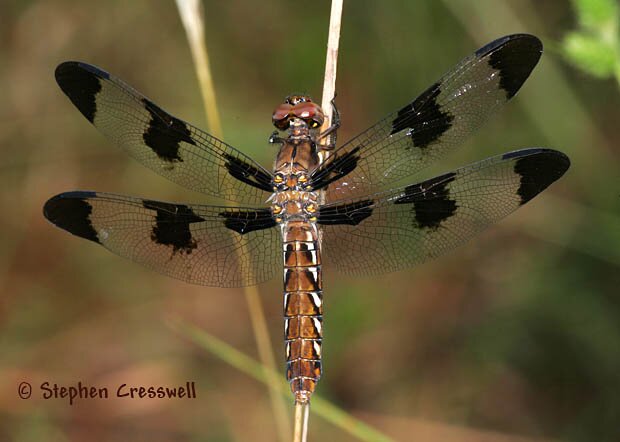

Family: Libellulidae
Length: typically 40-46 mm
The Common Whitetail is well named. It is one of the most abundant dragonflies in West Virginia, hence the "common" part is correct. And the bright white tail of older males is unmistakable. Younger males "tails" are powder blue, while the females abdomens are brown.
Mature males have a large brown band in the middle third of each wing. The thorax is dark brown, with two pale lateral stripes that fade with age. Eyes are dark. Males begin life with a brown abdomen with white hatch-marks like the females. Then the abdomen turns pale blue while the white hatch-marks remain. Later, white pruinosity obscures the blue abdominal color.
 Females and immature males have twelve dark wing spots, three on each wing, and in that way they resemble their relatives, the Twelve-Spotted Skimmers. Also like the Twelve-Spotted Skimmers females, the abdomen is brown. Unlike the female coloration of Twelve-Spotted Skimmers, though, the Common Whitetail female coloration has white hatch-marks, while in the Twelve-Spotted Skimmer there is a continuous yellow line down each side of the abdomen.
Females and immature males have twelve dark wing spots, three on each wing, and in that way they resemble their relatives, the Twelve-Spotted Skimmers. Also like the Twelve-Spotted Skimmers females, the abdomen is brown. Unlike the female coloration of Twelve-Spotted Skimmers, though, the Common Whitetail female coloration has white hatch-marks, while in the Twelve-Spotted Skimmer there is a continuous yellow line down each side of the abdomen.
Common Whitetails may be found at almost any body of water: ponds, lakes, marshes, and slower rivers. You may also spot them well away from water. The few counties in West Virginia with no records of Common Whitetails are those counties where almost no collecting has occurred. It is a safe bet that Common Whitetails live in all fifty-five counties. Elsewhere, the species is present in the 48 contiguous states and in southern Canada.
Note: This species, Libellula lydia, is sometimes referred to as Plathemis lydia.


